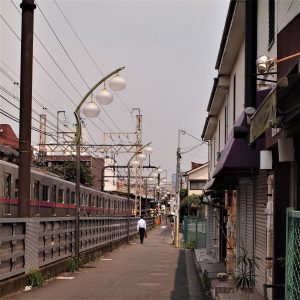Florian PURKARTHOFER
florian.purkarthofer[@]univie.ac.at
University of Vienna

The lingering scent of food served in small restaurants, the clattering sounds of commuter trains running along the tracks accompanied by a slight shaking of the uneven road – these and many more sensations are transmitted via streets and public spaces, as mode of mediation (Galloway, 2012, p. 54). The undetermined shared spaces enable movement in all directions and serve as canvas on which the everyday urban life is painted. Even though this might sound idyllic, the local public sphere created by streets is not limited to harmony and sympathy but it is also open to conflict, disturbance and unintended contact.
My project aims to shed light on the perception and construction of urban spaces and on how this process is enacted in Japan. The following questions stand at the centre: How does public space as mode of mediation frame perception and communication? And how do perception and communication construct public space in return?
These questions are answered by applying a mixed methodology employing multisensory participant observation (Pink, 2009), interviews, sense walks (Henshaw, 2014) and discourse analysis of two urban Tokyo neighbourhoods (Kitazawa and Matsubara, Setagaya-ward). In both areas, city planning projects as well as the modification of private railway tracks triggered discussions about how existing and new public spaces should be used, and who is entitled to advocate for them. Inhabitants, shopkeepers, activists and consumers share the streets, but perceive the space from different angles and participate in divergent but overlapping discourses.
Recent studies regarding urban localities in Japan helped to firmly situate my own research and narrow it down. Zukin, Kasinitz and Chen (2016) analysed shopping streets around the globe in a comparative study to better understand the mechanism of local shopping streets and their effects. The authors elaborated systematic connections between macroeconomics, micro level society, and communities. Disciplinary connected, but entirely focused on Japan, Miura (2016) demonstrated the micro dynamics of urban communities in contemporary Tokyo. In his empirical study he attempts to capture what (symbiotically) ‘living together’ means in a post-industrial society. In the same vein, but from an urban planner’s perspective, Aiba examined community participation in urban planning and urban change affecting communities (Fukazawa et al., 2000; Aiba and Satoh, 2003). Broadly based on these publications and the state of research, I attempt to connect spatial and social phenomena within an urban setting that has developed into an open concept of perception and communication. But, as warned by colleagues with good intentions, such an open approach also manifests itself in a multifaceted set of data that evades simple analyses. The urban mess, the disorderly situation in the streets, where concurrent events, constant flux and rich subtext dependency are the ordinary, emerges therefore as an important part of my dissertation.
My preliminary findings provide clear empiric evidence for the complexity of human interaction and information exchange on a micro level. The findings also urge me to not only describe these multifaceted phenomena, but also to discuss the different implications of information sharing through ‘space as mode of mediation’ – information perceived at location – and ‘spatial media’ – georeferenced information (digital or print) about a specific location (cf. Leszczynski, 2015) .
Overall, the modern (Japanese) city has been subject to academic inquiry for decades (Galloway et al., 2017; Tsukamoto and Almazán, 2006; Lützeler, 2008), but questions pertaining to its complex systems of culture, society and space still prevail. To obtain a better understanding of these complex urban systems, multiple perspectives and a variety of methods from the social sciences are necessary. In this vein, my project approaches urban spaces from different disciplines (urban studies, city planning, anthropology), methods and angles, but through the common denominator of everyday street life in western Tokyo in order to discuss urban spaces in Japan outside (or in between) the established boxes of academic traditions.
References
AIBA, S.; SATOH, S., 2003. Planning Method of the Process of Community Based Planning Which Starts After the Decision of Master Plan (Urban Planning). AIJ Journal of Technology and Design. 9(18), pp.307–12.
FUKAZAWA, K. 深沢一繁, AIBA, S. 饗庭伸, SHIMURA, H. 志村秀明, & SATŌ S. 佐藤滋. 2000. An Analysis of Mutual Editorial Process of Goal Image build through Rebuilding Design Game 建替えデザインゲームの分析による目標空間イメージの相互編集プロセスの解明. Toshi keikaku ronshū都市計画論文集. 35, pp.847–52.
GALLOWAY, A.R., 2012. The Interface Effect. Cambridge, UK: Polity Press. Available from: https://nyuscholars.nyu.edu/en/publications/the-interface-effect.
GALLOWAY, W.; KLINKERS, K.; SOLOMON,E.G.; PEIRRETI, A.; REDDON, N., What Rules Make (Tokyo’s Secret Code). In: MUNDLE, K., ed. HOUSE US. Winnipeg: OCDI Press, pp. 179–88.
HENSHAW, V., 2014. Urban Smellscapes: Understanding and Designing City Smell Environments. London: Routledge.
LESZCZYNSKI, A., 2015. Spatial Media/Tion. Progress in Human Geography. 39 (6), pp.729–51. Available from: https://doi.org/10.1177/0309132514558443.
LÜTZELER, R., 2008. Ungleichheit in der global city Tōkyō: aktuelle sozialräumliche Entwicklungen im Spannungsfeld von Globalisierung und lokalen Sonderbedingungen. München: Iudicium. MIURA, Rinpei 三浦 倫平. 2016. ‘Kyōsei’ no toshishakaigaku: Shimokitazawa saikaihatsu mondai no naka de kangaeru 「共生」の都市社会学: 下北沢再開発問のなかで考える. Tokyo: Shinyōsha.
PINK, S. 2009. Doing Sensory Ethnography. 1 Oliver’s Yard, 55 City.Road, London EC1Y 1SP United Kingdom: SAGE Publications Ltd. DOI:
10.4135/9781446249383.
TSUKAMOTO, Y., ALMAZÁN, J., 2006. Scrap and Build: Alternatives to the Corporate Redevelopment of Tokyo. MONU – Magazine on
Urbanism. 4, pp.6–9.
ZUKIN, S.; KASINITZ, P.; XIANGMING Chen. 2016. Global Cities, Local Streets: Everyday Diversity from New York to Shanghai. New York London: Routledge.
